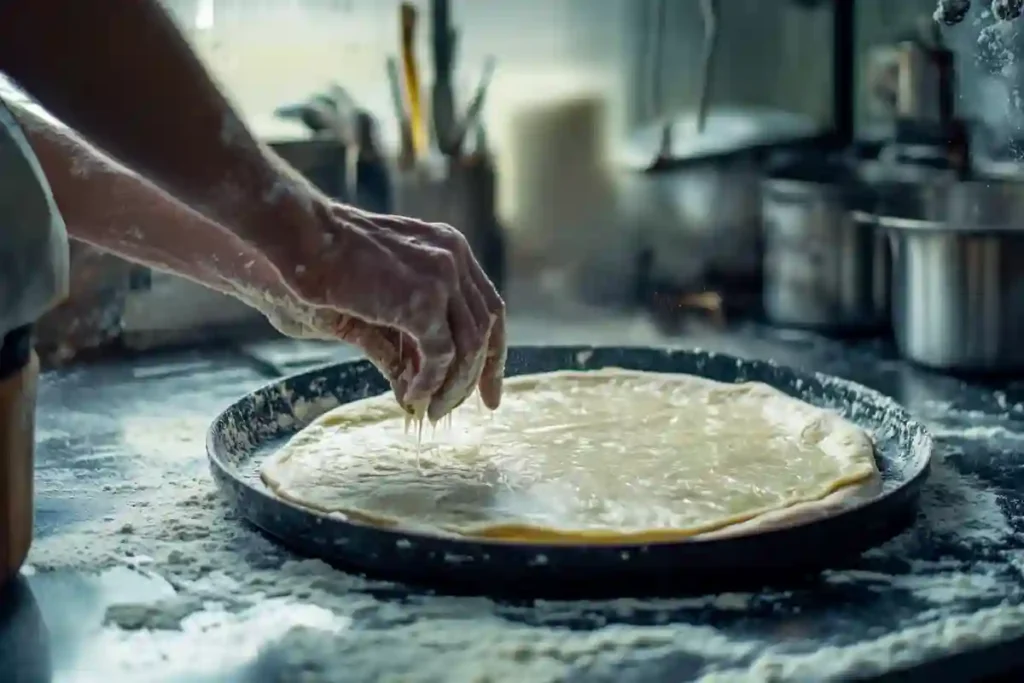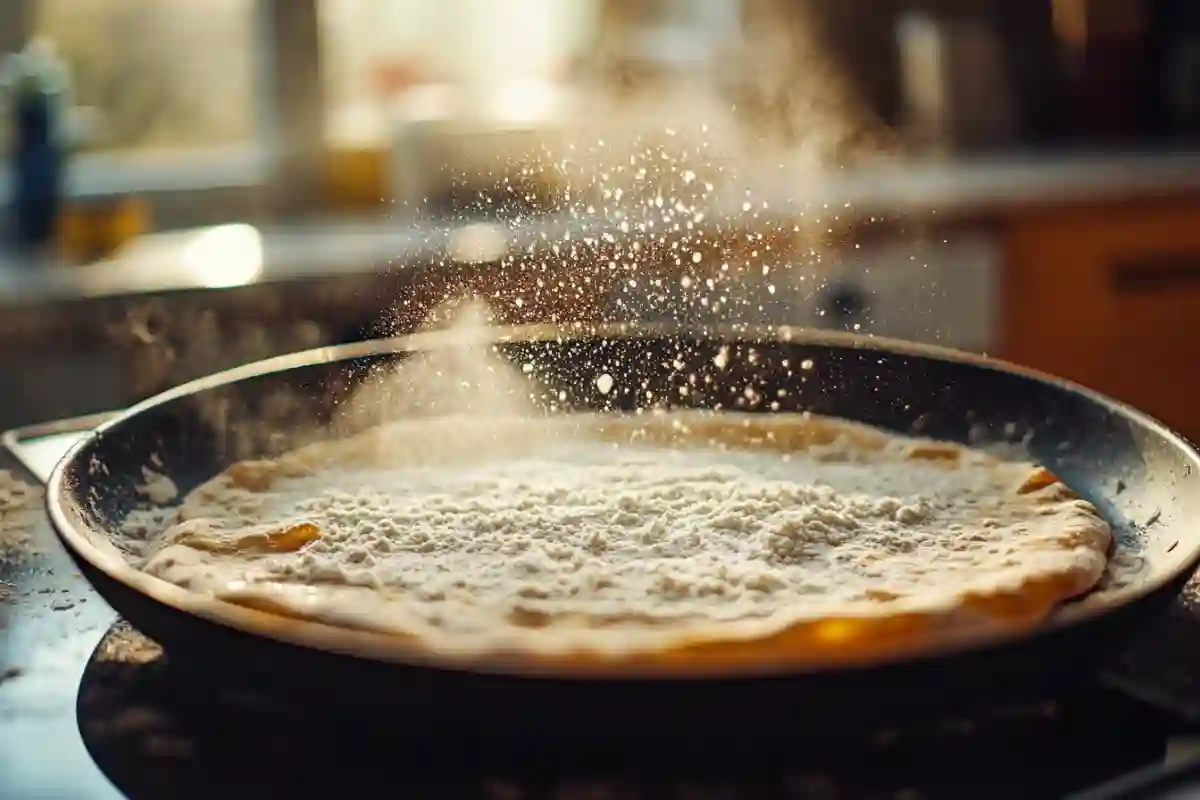When it comes to preparing the perfect homemade pizza, many ask, “Do you flour or oil a pizza pan?” The answer largely depends on the type of crust you want, the equipment you use, and personal preferences. This comprehensive guide explores the advantages of both methods, providing you with tips to enhance your pizza-making experience.
Introduction :
Making a delicious homemade pizza starts with a well-prepared pizza pan. Proper pan preparation ensures the crust cooks evenly and prevents sticking. But should you use flour or oil? While both options have their merits, understanding the differences can help you achieve the perfect crust. This guide covers everything you need to know to decide whether to flour or oil a pizza pan and offers tips to elevate your pizza game. From expert advice to practical techniques, you’ll have all the tools needed to create a restaurant-quality pizza at home.
Preparing your pizza pan properly is a simple but essential step. Whether you’re a beginner or an experienced pizza chef, learning the nuances of flour and oil can greatly influence the final result. In this article, we’ll explore each method in detail, address common questions, and provide actionable tips to enhance your overall pizza experience.
Why Prepare a Pizza Pan?
A prepared pizza pan ensures that your pizza crust comes out perfect every time. It eliminates the chances of the dough sticking, helps in even baking, and simplifies the cleanup process. Without proper pan preparation, you might end up with unevenly cooked pizzas or dough that clings stubbornly to the pan, ruining your meal.
One key reason for preparing your pizza pan is achieving that much-desired crisp crust. The right preparation method can make a significant difference in the texture of your pizza, from chewy Neapolitan-style to crispy thin crust. Additionally, preparation techniques help in creating a golden, visually appealing finish.
Moreover, choosing the right method for pan preparation affects the flavor of the crust. For instance, using a flavored oil, such as garlic-infused or herb-infused olive oil, can add a unique touch to your pizza. Flour, on the other hand, offers a more neutral but traditional pizzeria-style flavor. Whatever your choice, proper preparation guarantees consistency, making every bite as delicious as the last.
The Case for Oiling a Pizza Pan
Using oil is one of the most popular ways to prepare a pizza pan. It not only prevents sticking but also contributes significantly to the texture and flavor of the crust. Oiling a pizza pan is particularly beneficial when making pan pizzas, which require a crispy, caramelized edge.
Benefits of Oiling
- Prevents Sticking: A thin, even layer of oil ensures the dough won’t stick to the pan, allowing for easy removal.
- Enhances Flavor: Flavored oils, such as garlic-infused or chili-infused oil, can subtly elevate the taste of the crust.
- Encourages Browning: The oil creates a barrier between the dough and the pan, promoting a golden-brown crust.
- Versatile Use: Oiling works well for deep-dish pizzas, focaccias, and other bread-based recipes.
By understanding these benefits, you can use oil effectively to enhance your pizza-making results. Experimenting with different oils, such as avocado oil or sesame oil, can also introduce exciting new flavors to your homemade pizzas.
How to Oil a Pizza Pan
Follow these steps to oil your pizza pan effectively:
- Choose Your Oil: Select an oil with a high smoke point, such as vegetable oil, canola oil, or olive oil.
- Measure the Oil: Pour a small amount (about a teaspoon) onto the pan’s surface.
- Spread Evenly: Use a pastry brush or a clean paper towel to spread the oil across the pan, ensuring even coverage.
- Optional: Sprinkle a pinch of cornmeal or semolina over the oiled surface for added crispness.
This method is quick, easy, and guarantees a beautifully crispy crust every time. Oiling a pan is particularly effective for thicker, heartier crusts that benefit from additional browning.
The Case for Flour
Flouring a pizza pan is a tried-and-true method used by pizzerias worldwide. It’s especially effective for thin crusts, as it keeps the dough light and prevents sticking without adding unnecessary heaviness.
Benefits of Using Flour
- Non-Stick Properties: A light dusting of flour creates a barrier between the dough and the pan, ensuring it lifts off easily.
- Traditional Flavor: Flour imparts a classic, rustic flavor often associated with authentic pizzerias.
- Easy Cleanup: Excess flour can be brushed away effortlessly after baking, simplifying cleanup.
- Crisp Texture: Flour adds a subtle dryness to the crust, enhancing crispness without overpowering the dough’s flavor.
How to Flour a Pizza Pan
Flouring a pan is simple and effective. Here’s how:
- Choose Your Flour: Select a flour that complements your dough, such as all-purpose, semolina, or gluten-free options.
- Dust the Pan: Sprinkle a thin, even layer of flour across the pan’s surface.
- Shake Off Excess: Gently tap the pan to remove excess flour, ensuring even distribution.
- Optional: Mix the flour with a bit of cornmeal for added texture and flavor.
This method is ideal for lighter pizzas and works particularly well with non-stick pans. Flour’s simplicity and versatility make it a staple for pizza enthusiasts.
Flour vs. Oil: Which Is Better?
The choice between flour and oil often depends on personal preference and the type of pizza you’re making. Here are a few considerations to help you decide:
Type of Crust
- Thin Crust: Flour is better suited for thin, crispy pizzas as it keeps the dough light and airy.
- Thick Crust: Oiling the pan adds flavor and texture, ideal for pan pizzas or deep-dish styles.
Equipment
- Non-Stick Pans: Typically require less preparation, and a light dusting of flour may suffice.
- Cast Iron or Metal Pans: Benefit greatly from oiling, which helps with seasoning and non-stick properties.
Baking Goals
- If you prioritize a light, traditional flavor, go for flour.
- If you love crispy, golden-brown edges, oil is your best bet.

Combining Both Methods
Many seasoned pizza makers recommend using both flour and oil for the ultimate non-stick and flavorful results. By combining these techniques, you can achieve the best of both worlds:
- Lightly Oil the Pan: Spread a thin, even layer of oil on the pan’s surface.
- Dust with Flour: Sprinkle a fine layer of flour over the oiled surface.
- Distribute Evenly: Shake off any excess to prevent clumping.
This dual approach ensures a non-stick surface while enhancing the crust’s flavor and texture. It’s especially useful for pizzas with high moisture content, as it prevents sogginess.
Additional Sections
Using Parchment Paper
Parchment paper is another effective option for preparing a pizza pan. It provides a non-stick surface, making it ideal for beginners or those looking for an easy cleanup. Simply cut a sheet to fit your pan, place it on the surface, and add your dough. While it doesn’t enhance crispness like oil, it’s a practical alternative. It works especially well for delicate pizzas like Margherita or white pizzas where sticking could compromise the appearance.
Moreover, parchment paper ensures even heat distribution without altering the flavor of the crust. It is particularly useful for those experimenting with sticky doughs or alternative crusts like cauliflower or gluten-free options. Although parchment paper doesn’t add crispness, it does create a seamless baking and cleanup experience, making it a preferred choice for many home cooks.
Experimenting with Seasonings
To add an extra layer of flavor, consider seasoning your pizza pan. Mix herbs like oregano, thyme, or rosemary with your chosen flour or oil. These seasonings infuse the crust with a delightful aroma and taste. Additionally, incorporating grated parmesan or garlic powder into the preparation mix elevates the flavor profile of your pizza.
Seasoned pans are a game-changer for pizza enthusiasts seeking a unique twist. The added layer of seasoning not only enhances the crust but also complements various toppings, creating a harmonious blend of flavors. Experimenting with seasonings is an excellent way to personalize your pizza while maintaining the integrity of traditional techniques.
Alternative Flours
If you’re avoiding traditional flours, try alternatives like almond flour, chickpea flour, or coconut flour. These options cater to gluten-free diets while adding unique flavors and textures to your pizza. Almond flour, for instance, offers a nutty flavor that pairs well with Mediterranean toppings, while chickpea flour provides a hearty base for vegetable-heavy pizzas.
Coconut flour, on the other hand, is ideal for those seeking a slightly sweet crust to complement Hawaiian-style pizzas. These flours require adjustments to dough hydration levels due to their differing absorbencies, but the results are worth the effort. Alternative flours are not only versatile but also open up endless possibilities for creating innovative pizzas that cater to specific dietary needs.
Frequently Asked Questions
Can You Use Both Flour and Oil on the Same Pan?
Yes, combining flour and oil is highly effective for preventing sticking and creating a flavorful crust. This method is especially useful for high-moisture pizzas or thicker doughs, as it prevents sogginess while ensuring the crust develops a crispy texture.
What’s the Best Substitute for Flour on a Pizza Pan?
Cornmeal is an excellent substitute for flour. It adds a delightful crunch and prevents sticking without altering the dough’s flavor. Other options include semolina or rice flour for a unique twist.
Does Oiling a Pizza Pan Change the Flavor of the Crust?
Oiling a pizza pan can enhance the flavor of the crust, especially if you use flavored oils like garlic or basil-infused oils. Neutral oils such as canola won’t alter the taste significantly.
How Much Flour or Oil Should I Use?
For flour, a light dusting is sufficient to coat the pan evenly. For oil, use about a teaspoon to avoid pooling while ensuring full coverage of the surface.
Is Parchment Paper Better Than Oil or Flour?
Parchment paper offers a non-stick solution and simplifies cleanup. However, it doesn’t contribute to crust crispiness the way oil does, nor does it provide the traditional flavor associated with flour.
Can You Skip Pan Preparation Entirely?
Skipping pan preparation increases the risk of the dough sticking and uneven baking. Proper preparation is essential for achieving the desired texture and ensuring easy removal of the pizza.
Conclusion
Do You Flour or Oil a Pizza Pan? Here’s What You Need to Know
When it comes to crafting the perfect homemade pizza, one question often arises: Should you flour or oil a pizza pan? The answer depends on your desired crust and the type of pizza you’re making. Both methods have their own advantages that can elevate your pizza to restaurant-quality levels.
Flouring the Pizza Pan for a Light, Traditional Crust
Flouring your pizza pan is ideal for achieving a light, airy crust with that classic pizzeria-style texture. The flour acts as a barrier between the dough and the pan, preventing sticking and allowing the crust to cook evenly. This method is perfect for thin-crust pizzas where a delicate, crisp base is essential.
Oiling the Pizza Pan for Added Flavor and Crispiness
If you’re aiming for a thicker crust or a deep-dish pizza, oiling the pan can enhance both flavor and texture. Oil adds a richness to the dough and promotes a crispy, golden bottom. It not only prevents the crust from sticking but also gives it a delightful crunch that’s especially enjoyable in heartier pizzas.
Combining Flour and Oil for the Best of Both Worlds
For the ultimate pizza-making experience, consider using both flour and oil on your pizza pan. Start by lightly oiling the pan and then dust it with flour. This combination ensures easy release, adds flavor, and provides the desired crispiness, resulting in a homemade pizza that’s a true culinary success.
Experiment with Different Techniques
Don’t hesitate to try various methods to find what works best for your taste buds. From using parchment paper to experimenting with alternative flours like cornmeal or semolina, different techniques can offer unique textures and flavors. Each variation brings something new to the table, making your pizza-making journey even more enjoyable.
Related article : Pizza Pan: How to Choose the Best One

